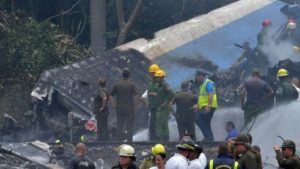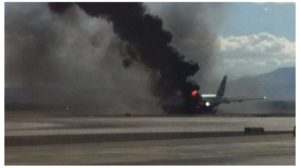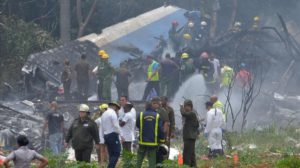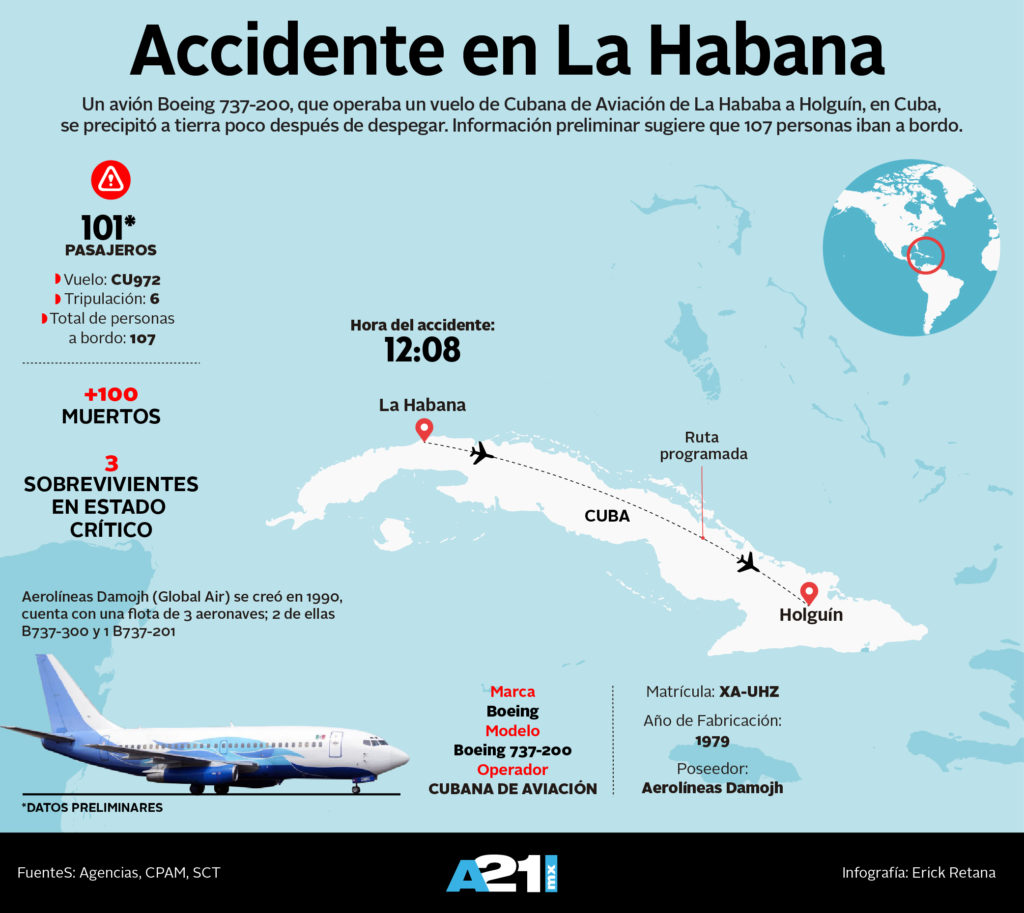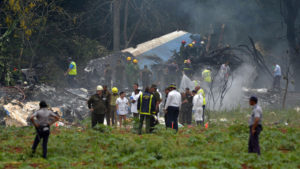Los restos de las primeras víctimas identificadas retornaron este domingo a sus lugares de origen mientras avanza la investigación del siniestro del vuelo DMJ-972 de Cubana de Aviación en el que el viernes murieron 110 personas cuando el avión se estrelló poco después de despegar del aeropuerto de La Habana.
La zona de cultivos en la que cayó la aeronave, a un kilómetro del recinto aeroportuario, centra los trabajos de la comisión de investigación formada por las autoridades cubanas, a la que se han empezado a sumar expertos de otros países sin que todavía haya una explicación de lo sucedido.
Los expertos tratan de reunir piezas del fuselaje, los motores y el interior del aparato, que Cubana tenía alquilado desde hace menos de un mes a la aerolínea mexicana Global Air, responsable del mantenimiento del avión, un Boeing 737 fabricado en 1979.
Esos restos se trasladan a una dependencia aeroportuaria para su posterior evaluación, explicó el jefe de la comisión de investigación y presidente del Instituto de Aeronáutica Civil de Cuba (IACC), Armando Daniel López, citado por medios estatales.
También se busca la segunda de las dos cajas negras del avión, la que registra los parámetros técnicos del vuelo, aunque “su hallazgo no es determinante para arribar a una conclusión”, precisó el funcionario.
La primera caja negra, que graba los sonidos en la cabina de control, se recuperó horas después del accidente y hasta ahora no se ha difundido su contenido.
Este domingo se unieron a la investigación dos expertos de las autoridades aeronáuticas de México, país de origen de la aerolínea propietaria del aparato, que superó la última revisión técnica en noviembre del año pasado.
Cubana de Aviación lo operaba en régimen de alquiler pero el contrato de arrendamiento estipulaba que el mantenimiento técnico era responsabilidad de Global Air, la compañía propietaria, también registrada como Damojh.
La Dirección General de Aeronáutica Civil (DGAC) de México anunció este domingo una nueva auditoría a Damojh para “verificar que las condiciones actuales de operación sigan cumpliendo con la normatividad” y colaborar con la investigación.
Además, el ministro cubano de Transporte, Adel Yzquierdo, avanzó la llegada de peritos de aseguradoras de países europeos y expertos de Estados Unidos y garantizó que se permitirá que participen en la investigación “cuantas personas jurídicas y naturales tengan derecho, como el fabricante, propietario y las autoridades de la nación de origen del avión”.
La zona del accidente, a un kilómetro del aeropuerto habanero, se mantendrá preservada el tiempo necesario, pues los trabajos pueden prolongarse “días, semanas y hasta meses”, advirtió.
Todos los restos humanos han sido recuperados y trasladados al Instituto de Medicina Legal de La Habana, donde hasta ahora han sido identificados 33 de los 110 cadáveres.
Las tres supervivientes, de 19, 23 y 39 años y nacionalidad cubana, mantienen un estado “crítico grave” debido a los severos traumas craneales, fracturas y quemaduras sufridas en el siniestro, y se encuentran acompañadas por sus familiares en el centro sanitario, con todo el país pendiente de su recuperación.
También ha comenzado el proceso de identificación de los seis integrantes de la tripulación de la aeronave, todos mexicanos, con la presencia en La Habana de 15 familiares que han sido entrevistados por los expertos forenses cubanos.
Como la investigación, también se espera que el reconocimiento de las víctimas dure varias semanas, indicó el director del organismo forense, Sergio Rabell.
Los familiares de la mayoría de las víctimas se encuentran en La Habana para colaborar en la identificación de sus seres queridos, y también están ya en la capital cubana los allegados de los seis miembros de la tripulación.
Los parientes, cuya estancia costea el Gobierno cubano, se alojan en un hotel y son atendidos por médicos y psicólogos especializados en este tipo de situaciones.
A la provincia de Holguín, a cuya capital se dirigía el avión accidentado y donde residían 67 de las víctimas, llegaron ayer los restos ya identificados de tres de las personas fallecidas
Se trata de Suyen Lizandra Figueredo y su hija de siete años, Alexa Rivas Figueredo, recibidos por “una representación masiva” del municipio de Gibara, donde vivían; y de Yunaisi Pelegrino, de 39 años y vecina de Holguín.
Alexa Rivas es una de los cinco menores que perecieron en el vuelo, en el que también perdieron la vida otros tres niños de dos, cuatro y cinco años y una bebé de quince meses.
En el siniestro murieron 99 personas de nacionalidad cubana y once extranjeros: siete mexicanos -los seis miembros de la tripulación y una turista-, dos argentinos, un saharaui y un saharaui con nacionalidad española.
The remains of the first identified victims returned to their places of origin on Sunday as the investigation of the flight of DMJ-972 of Cubana de Aviación advances, in which 110 people died on Friday when the plane crashed shortly after taking off from the airport. Havana.
The area of crops in which the aircraft fell, one kilometer from the airport, centers the work of the commission of inquiry formed by the Cuban authorities, which has begun to add experts from other countries without there still being an explanation from what has occured.
The experts try to gather pieces of the fuselage, the engines and the interior of the aircraft, which Cubana had hired for less than a month to the Mexican airline Global Air, responsible for the maintenance of the plane, a Boeing 737 manufactured in 1979.
These remains are transferred to an airport dependency for further evaluation, explained the head of the commission of investigation and president of the Institute of Civil Aeronautics of Cuba (IACC), Armando Daniel López, quoted by state media.
The second of the two black boxes of the plane is also being searched, which records the technical parameters of the flight, although “its finding is not decisive to arrive at a conclusion,” the official said.
The first black box, which records the sounds in the control cabin, was recovered hours after the accident and until now its content has not been disseminated.
This Sunday, two experts from the aeronautical authorities of Mexico, the country of origin of the airline that owns the aircraft, joined the investigation, which surpassed the last technical revision in November of last year.
Cubana de Aviación operated it on a rental basis but the lease agreement stipulated that the technical maintenance was the responsibility of Global Air, the owner company, also registered as Damojh.
The General Direction of Civil Aeronautics (DGAC) of Mexico announced on Sunday a new audit to Damojh to “verify that the current operating conditions continue to comply with the regulations” and collaborate with the investigation.
In addition, the Cuban Minister of Transport, Adel Yzquierdo, advanced the arrival of experts from insurers from European countries and experts from the United States and guaranteed that they will be allowed to participate in the investigation “as many legal and natural persons as they are entitled, as the manufacturer, owner and the authorities of the nation of origin of the plane. ”
The area of the accident, one kilometer from the Havana airport, will be preserved for the necessary time, since the work can be extended “days, weeks and even months”, he warned.
All human remains have been recovered and taken to the Legal Medicine Institute of Havana, where up to now 33 of the 110 corpses have been identified.
The three survivors, aged 19, 23 and 39 and Cuban nationality, maintain a “critical serious” state due to the severe cranial traumas, fractures and burns suffered in the accident, and are accompanied by their relatives in the health center, with the whole country awaiting recovery.
The process of identifying the six members of the crew of the aircraft, all Mexicans, has also begun, with the presence in Havana of 15 relatives who have been interviewed by Cuban forensic experts.
As the investigation, the recognition of the victims is also expected to last several weeks, said the director of the forensic body, Sergio Rabell.
The relatives of most of the victims are in Havana to collaborate in the identification of their loved ones, and the relatives of the six crew members are already in the Cuban capital.
The relatives, whose stay is paid by the Cuban Government, stay in a hotel and are attended by doctors and psychologists specialized in this type of situation.
To the province of Holguín, to whose capital the crashed plane was headed and where 67 of the victims resided, arrived yesterday the remains already identified of three of the deceased
This is Suyen Lizandra Figueredo and her seven-year-old daughter, Alexa Rivas Figueredo, received by “a massive representation” of the municipality of Gibara, where they lived; and Yunaisi Pelegrino, 39 years old and neighbor of Holguín.
Alexa Rivas is one of the five children who died on the flight, in which three other children of two, four and five years and a fifteen-month-old baby also lost their lives.
In the incident, 99 people of Cuban nationality and eleven foreigners died: seven Mexicans -the six crew members and one tourist-, two Argentines, a Saharawi and a Saharawi with Spanish nationality.
Agencies/EFE/14ymedio/Lorena Cantó,La Habana/ Internet Photos/ Arnoldo Varona/ TheCubanHistory.com
THE CUBAN HISTORY, HOLLYWOOD.



